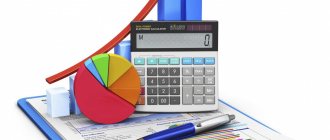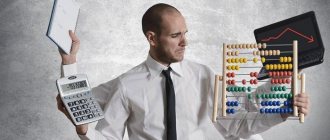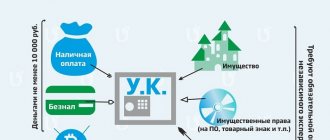Purpose of account 62
The account is intended to record information about transactions with counterparties purchasing its goods (work, services) from the organization. As a general rule, account 62 reflects transactions on those products of the organization that relate to its main activities. To record one-time or atypical transactions for an organization, account 76 of the chart of accounts is intended (approved by order of the Ministry of Finance dated October 31, 2000 No. 94n).
All the features of filling out the register for settlements with customers are given in the article “Features of the balance sheet for account 62”.
Subaccounts
For a detailed analysis of the organization’s emerging costs and recording the income received from operations not related to normal activities, the account provides for the opening of sub-accounts:
91.01 Information is collected on receipts recognized as income of the company, not related to ordinary activities (passive sub-account);
91.02 Information about the company’s expenses not related to ordinary activities (for example, expenses for bank services) - active subaccount;
91.09 This subaccount is the calculated financial result for transactions not related to the company’s normal activities.
The nuances of using subaccounts using the example: Dt 62.1 Kt 62.2
On account 62, analytical accounting should be provided according to the following parameters:
- According to issued invoices.
- For each counterparty.
- By groups of affiliated persons (with whom consolidated reporting should then be prepared).
- By payment characteristics (received prepayments, postpayments).
These tasks are solved, among other things, through the opening of sub-accounts to account 62.
Subaccounts are usually identified by an additional numeric coding of one or two characters added to the main account code. In the original chart of accounts, a unified standard for creating subaccounts for account 62 is not provided. But as a result of the widespread use of computer programs, assigning a subaccount code in practice is approximately the same.
For example:
- Account 62.1 (or 62.01 in most current versions of accounting programs) is assigned to account for postpaid settlements. When the goods have been shipped (services have been provided) but payment has not yet been received. The balance according to 62.1 is debit and means that the buyer (customer) owes the organization for the part of the transaction that it has already completed.
- Account 62.2 (or 62.02) is used to record received payments against future shipments (performance of work, provision of services). The balance is a credit balance and characterizes the size of the organization’s obligations to counterparties who have made prepayments for transactions.
Read more about accounting automation in the material “Review of programs for accounting expenses and income of an organization.”
What does the posting Debit 62 Credit 62 mean?
Posting Dt 62 Kt 62 always means making changes according to calculations. There are three possible options:
- Debit 62 Credit 62 between subaccounts.
Example
is part of a group of companies preparing consolidated financial statements. Technotrade accounts for settlements with companies in its group in account 62.4. The company has a counterparty, LLC "Zapchasti", which has a credit balance of 62.2. received information that Zapchasti LLC was included in the same group on the date the balance was formed. That is, settlements with Zapchasti LLC will be considered intra-group. Technotrade LLC is posting Dt 62 Kt 62 (Dt 62.2 Kt 62.4) for the amount of the advance payment from Spare Parts LLC.
- Debit 62 Credit 62 between counterparties.
Example
Stroymontazh LLC performed repair work for the customer 1 per 100,000 rubles. and customer 2 for 80,000 rubles. The customers are affiliated persons, resulting in payment under both contracts in the amount of 180,000 rubles. received from customer 1. Stroymontazh LLC accepted this payment, securing its terms in an additional agreement with customers. To correctly reflect the calculations, the accountant of Stroymontazh LLC made a posting of Dt 62 / customer 1 Kt 62 / customer 2 for 80,000 rubles.
- Debit 62 Credit 62 for two transactions.
Example
Stroymontazh LLC contracted to perform work at several sites of one customer. At site 1, the work has been completed, but not all of it has been paid for. An advance payment has been received for object 2, but work is still underway. The customer proposed to offset part of the prepayment for object 2 to pay off his debt for object 1. According to the corresponding additional agreement, Stroymontazh LLC will make an entry in its accounting Dt 62 / customer / object 2 Kt 62 / customer / object 1 for the balance of the customer’s debt for the object 1.
Wiring Dt 62 Kt 90 and Dt 62 Kt 91
Debit 62 Credit 90 and Debit 62 Credit 91 appear in accounting in connection with the receipt of income by the organization.
Dt 62 Kt 90 means reflecting revenue from main activities.
Dt 62 Kt 91 will be needed to reflect other operations. This may include income from:
- from the sale of fixed assets;
- from external sales of materials;
- from writing off expired accounts payable.
For an example of accounting entries for mutual settlements with buyers and customers, see.
Read more about this in the article “Writing off accounts payable with an expired statute of limitations.”
2) Contribution to the authorized (share) capital, mutual fund
Account 91 “Other income and expenses” is used to display information on non-operating income and arising costs of the company for operations not related to normal activities.
Account 91 in accounting is used by legal entities to collect information on the company’s income and expenses that are not related to normal activities.
Sch.91 is considered to be active-passive. The loan displays information about income from the following operations:
- provision of temporary use of the company’s own assets (corresponds with the accounts of mutual settlements and funds);
- provision of patents, intellectual property products, etc. for a fee;
- participation in the authorized capital of third-party companies;
- sale of own equipment;
- surplus goods and materials identified during the inventory;
- write-off of expired accounts payable;
- interest paid by counterparties for loans and credits provided;
- exchange differences;
- profit of previous years accepted in the reporting period, etc.
Account debit – reflection of the company’s other expenses:
- bank commission costs;
- shortages and damage to products and goods and materials, for which the perpetrators have not been identified or there is a court conclusion refusing to reimburse costs;
- fines and penalties required to be paid due to violations of the terms of agreements with counterparties;
- charity;
- interest on loans and borrowings;
- costs associated with the write-off of fixed assets and other assets of the company (with the exception of cash);
- write-off of expired accounts receivable;
- legal costs;
- exchange differences;
- losses of previous years accepted in the reporting period, etc.
Wiring Dt 62 Kt 76
In its meaning, the posting is similar to the posting Debit 62 Credit 62 and means some change either in the type of settlement or in the status of the counterparty. Only for transferring debt amounts, not an analytical account is used for account 62, but account 76. In this case, account 76 takes into account transactions that are not mentioned in the instructions for accounts 60 to 75. Including, in relation to buyers and customers, these may be calculations:
- for transactions that differ from ordinary transactions in the main activity;
- on insurance and intermediation operations;
- on claims (for example, on fines for violation of contract terms).
Example
The carrier company transported a consignment of the customer’s goods and additionally arranged insurance for these goods en route. To ensure analytical accounting, the carrier company accountant divided the total invoice amount presented to the customer into services for the main activity (transportation) and additional insurance services:
Dt 62 Kt 76 - for the amount of the cost of insurance of the customer’s cargo.
Accounting entries for main business transactions from account 91
- Inventory results:
Dt91.02 Kt94 – shortages in excess of the norms of natural loss; defect, the culprits of the damage have not been found or there is a court decision refusing compensation;Dt 10,41,20,43 Kt91.01 – capitalization of surplus inventory, goods, work-in-progress products, etc.;
- Revaluation of fixed assets:
Dt91.02 Kt01 – reduction in the cost of fixed assets. - Write-off of assets:
Dt91.02 Kt04.10 – intangible assets, materials in connection with the sale or write-off;Dt91.02 Kt08 – investments in non-current assets are recognized as other expenses in connection with their write-off, sale or partial liquidation.
- Exchange differences:
Dt91.02 Kt50,60,62 – negative exchange rate differences on cash in foreign currency, accounts payable, accounts receivable;Dt50,60,67,62,66 Kt91.01 – positive exchange rate differences.
- Financial result for other operations:
Dt91.09 Kt99 – profit;Dt99 Kt91.09 – loss.
- Write-off of expired debts:
Dt91.02 Kt60.62 – accounts receivable;Dt60.62 Kt91.01 – write-off of accounts payable.
- Interest on loans and borrowings:
Dt91.02 Kt66.67 – payment of interest to counterparties;Dt73 Kt91.01 – accrual of interest for the use of company funds by employees.
- Penalties and fines accrued to an organization for non-compliance with the terms of contracts:
- Receipts of funds for sold property of the company:
Victor Stepanov, 2017-12-04
D 01 K 91 subaccount “Other income”
Purchased books, brochures and other publications may be written off as production costs as they are released into production or operation. Accounting for purchased publications as fixed assets is possible only if there is a library fund. Correspondence of accounting accounts for transactions of acquisition and transfer of books into operation:
D 08 K 60(71)¾accepted books at nominal acquisition cost;
D 19 K 60¾ VAT presented by the supplier is taken into account;
D 01 K 08 ¾ books were transferred for use;
D 26(44) K 01 ¾ the cost is written off upon transfer for use.
The choice of the option of reflecting books and brochures on accounting accounts will not affect the financial statements and the amount of taxes, but this choice determines which forms of primary documents will be filled out: documents reflecting the movement of fixed assets or documents reflecting the movement of inventory.
(3)
Based on decapitalization methods, fixed assets can be grouped as follows:
objects whose value is not decapitalized (depreciated), since their consumer properties do not change over time. These include land plots, natural resources and works of art;
objects that wear out, but in accordance with current legislation are not depreciated. These include: housing facilities (if they are not used to generate income), external improvement facilities and other similar facilities (forestry facilities, road facilities, etc.); perennial plantings that have not reached operational age. For the specified fixed assets and non-profit fixed assets, at the end of the reporting year, depreciation is accrued according to established depreciation rates (on off-balance sheet account 010 “Depreciation of fixed assets”). Clause 17 of PBU 6/01 contains a list of fixed assets, the cost of which is not repaid, i.e. depreciation is not accrued for these objects, but depreciation is accrued at the end of the reporting year according to established depreciation rates;
objects, the cost of which is allowed to be written off as production costs (selling expenses) as they are released into production and operation as part of inventories. These include fixed assets worth no more than the established limit per unit (RUB 20,000), as well as purchased books, brochures and similar publications. In order to ensure the safety of these objects, proper control over their movement must be organized;
objects that are subject to decapitalization through depreciation.
The cost of an organization's fixed assets is repaid through straight-line or accelerated depreciation over its useful life. Only during the conservation of objects does depreciation on them stop. The duration of preservation must be at least three months. Currently, depreciation is calculated regardless of the results of the organization’s economic activities in the reporting period in one of the following ways:
Ø linear method;
Ø reducing balance method;
Ø method of writing off value by the sum of the numbers of years of useful life;
Ø method of writing off cost in proportion to the volume of products (works).
During the reporting year, depreciation charges for fixed assets are accrued monthly, regardless of the accrual method used, in the amount of 1/12 of the annual amount.
The objects for calculating depreciation are fixed assets that are the property of the organization, accepted for economic management and operational management. The amounts of depreciation charges for fixed assets are recorded in accounting by accumulating them during the depreciation period on synthetic account 02 “Depreciation of fixed assets.” The chosen method of calculating depreciation must be applied throughout the entire useful life of the asset. Fixed assets worth no more than 20,000 rubles. are taken into account as part of inventories and are written off as they are released into production.
With the linear method, the annual amount of depreciation is determined based on the initial, current, replacement (in case of revaluation) cost of the fixed asset and the average annual depreciation rate calculated based on its useful life.
With the reducing balance method, the annual amount of depreciation is determined based on the residual value of the fixed asset item at the beginning of the reporting year and the depreciation rate calculated based on the useful life of this item and the acceleration factor.
Ost. St-th×depreciation rate
Depreciation rate = to/life of use
When using the method of writing off cost by the sum of the number of years of its useful life, the initial cost of the fixed asset is multiplied by the ratio of the number of years of the remaining service life of the object and the sum of the number of years of its service life.
Perv. Or ost. We're standing. × number of years until the end/sum of numbers of years
When writing off the cost in proportion to the volume of products (work), depreciation charges are calculated by multiplying the initial cost of the object (completed work) and their estimated (calculated) value for the entire useful life of the object.
Perv. We're standing. /estimated volume ×actual volume
For fixed assets that were in operation before acquisition, the expected useful life of the next owner is determined by subtracting the time of their actual use until the moment of sale or transfer from the service life of new objects. To apply independently calculated depreciation rates for purchased fixed assets that were previously in use, the buyer should obtain from the seller documents confirming the period of actual use of the purchased objects. If an object is purchased whose useful life has reached its standard service life, the possible period of its further use is determined by the buyer independently.
Depreciation is charged monthly on newly registered fixed assets starting from the 1st day of the month following the month of receipt. For retired objects, depreciation is stopped on the 1st day of the month following the month of their retirement or complete write-off. The amount of accrued depreciation of fixed assets is included in production costs (selling expenses) and is recorded on account 02 in the corresponding sub-accounts opened on the basis of property ownership.
D 20, 23 (if direct costs) K 02 for the corresponding subaccounts;
For fixed assets of the main production of business entities, in the calculation of the cost of production of which depreciation is highlighted as a separate item, as well as if the costs of servicing and managing auxiliary production are taken into account in the corresponding account.
D 25, 26 (if indirect costs) K 02 for the corresponding subaccounts;
In the first case, depreciation is calculated on buildings, structures, machinery and equipment of the workshop. In the second ¾ of fixed assets of a general plant nature.
Print (Ctrl+P)
Information for 1C users: Integrated automation 1.1
Typical transactions for account 50 “Cash desk”
Home Favorites Random article Educational New additions Feedback FAQPage 1 of 2Next ⇒
Typical transactions for account 50 “Cash desk”
Dt 50 Kt51 Cash withdrawn from the current account was entered into the cash register
Dt50 Kt 55 Cash withdrawn from a special bank account was credited to the cash register
Dt50 Kt60 The supplier returned to the cashier the funds overpaid to him or the advance payment given to him
Dt50 Kt62 Cash received from buyers was credited to the cash register or the buyer made an advance payment
Dt50 Kt71 Unused funds previously issued as a report were returned to the cash desk
Dt50 Kt73-2 Cash received from an employee to compensate for material damage was entered into the cash register
Dt 50 Kt 75-1 Cash contributed as a contribution to the authorized capital was capitalized
Dt 51 Kt 50 Cash was deposited from the cash register to the current account
Dt 55 Kt 50 Cash was deposited from the cash register into a special bank account
Dt 58-1 Kt 50 Shares purchased for cash
Dt 58-2 Kt 50 Debt securities were purchased for cash
Dt 60 Kt 50 The debt to the supplier (contractor) was repaid in cash or an advance was issued in cash
Dt 62 Kt 50 Cash paid in excess by the buyer (customer) was returned or the advance was returned
Dt 69-1 Kt 50-2 Vouchers were issued to employees, paid for from social insurance funds
Dt 70 Kt 50 Wages paid to employees from the cash register
Dt 71 Kt 50 Cash issued on account
Dt 73-1 50 Loan issued to employee
Dt 75-2 Kt 50 Dividends (income) were paid from the cash register to the founder (participant) of the organization
Dt 76-4 Kt 50 Deposited wages paid from the cash register
Dt 94 Kt 50 The shortage of cash in the organization’s cash desk is reflected (during an inventory or audit of the cash register)
Dt 99 Kt 50 Lost cash and monetary documents were written off as losses due to emergency circumstances
Typical transactions for account 51 “Current accounts”
Dt 51 Kt 50 Cash from the organization’s cash desk was deposited into the current account
Dt 51 Kt 51 Funds were transferred from one current account to another
Dt 51 Kt 55 Funds were transferred from a special bank account to a current account
Dt 51 Kt 60 The supplier returned the overpaid funds or advance payment to the bank account
Dt 51 Kt 62 Funds received from the buyer are credited to the current account or an advance is transferred
Dt 51 Kt 66 Cash received under a short-term loan agreement was credited to the current account
Dt 51 Kt 67 Cash received under a long-term loan agreement was credited to the current account
Dt 51 Kt 71 Unused funds previously issued for reporting were returned to the current account
Dt 51 Kt 75-1 Funds were received into the current account as a contribution to the authorized capital
Dt 51 Kt 76-1 Insurance compensation received from the insurance company is credited to the current account
Dt 51 Kt 76-2 Funds are credited to the current account for a recognized (awarded) claim
Dt 51 Kt 90-1 Funds for sold products (goods, works, services) were credited to the current account
Dt 51 Kt 91-1 Funds from the sale of other property received to the current account are reflected in other income
Dt 51 Kt 98-1 Deferred income received in non-cash funds
Dt 51 Kt 99 Non-cash funds were received into the current account as a result of emergency events
Dt 50 Kt 51 Cash withdrawn from the current account was credited to the cash register
Dt 55 Kt 51 Funds were transferred from the current account to a special account in the bank
Dt 58-1 Kt 51 The cost of the acquired shares was paid from the current account
Dt 58-2 Kt 51 Paid from the current account the cost of purchased debt securities
Dt 60 Kt 51 The debt to the supplier (contractor) has been repaid with non-cash funds or an advance has been issued
Dt 62 Kt 51 The funds paid in excess by the buyer were returned from the current account or the advance was returned
Dt 66 Kt 51 Cash was written off from the current account to repay a short-term loan and interest on it
Dt 67 Kt 51 Cash was written off from the current account to repay a long-term loan and interest on it
Dt 68 Kt 51 Taxes and fees to the budget were paid from the current account
Dt 69-1 Kt 51 The unified social tax was paid from the current account in the part subject to credit to the social insurance fund
Dt 69-2Kt 51 The unified social tax was paid from the current account in the part subject to credit to the pension fund
Dt 69-3 Kt 51 The unified social tax was paid from the current account in the part subject to credit to the compulsory health insurance fund
Dt 70 Kt 51 Employees' wages were transferred from the current account
Dt 71 Kt 51 Funds from the current account were issued for reporting
Dt 75-2 Kt 51 Non-cash funds were used to pay dividends to the founder of the organization
Dt 84 Kt 51 Expenses were paid from the current account using retained earnings
Dt 96 Kt 51 Various expenses were paid from the current account at the expense of a previously created reserve
Dt 99 Kt 51 Expenses related to eliminating the consequences of emergency situations were paid from the current account
Typical transactions for account 58 “Financial investments”
Dt 58-1 Kt 51 Purchased shares paid from the current account
Dt 58-2 Kt 51 Purchased debt securities paid from the current account
Dt 58-3 Kt 51 Funds were transferred from the current account under the loan agreement
Dt 51 Kt 58-3 Loan returned to the current account
Dt 91-2 Kt 58-1 The cost of shares disposed of as a result of the sale is included in
other expenses (sale of securities is not the subject of the organization’s activities)
Dt 91-2 Kt 58-2 The cost of debt securities disposed of as a result of sale is included in other expenses (the sale of securities is not the subject of the organization’s activities)
Typical entries for account 59 “Provisions for impairment of investments in securities”
Dt 59 Kt 91-1 The reserve for impairment of investments in securities that was not used at the end of the reporting period is included in other income
Dt 59 Kt 91-1 The reserve for impairment of investments in securities was reduced by the amount of the increase in the market value of securities
Dt 59 Kt 91-1 The amount of the created reserve upon disposal of securities from the organization’s balance sheet is written off
Dt 91-2 Kt 59 A reserve has been created for the impairment of investments in securities
Dt 91-2 Kt 59 The reserve for impairment of investments in securities was increased by the amount of the decrease in the value of securities
Typical transactions for account 07 “Equipment for installation”
Dt 07 Kt 23 The costs of auxiliary production associated with the delivery and setup of equipment are written off to increase its cost
Dt 07 Kt 60 Equipment requiring installation has been capitalized
Dt 07 Kt 66 Interest on short-term loans and borrowings received for the purchase of equipment is taken into account when determining its cost
Dt 07 Kt 67 Similarly for long-term loans and borrowings
Dt 07 Kt 71 Equipment purchased by the accountable person was capitalized; expenses related to the delivery of equipment were paid by the accountable person
Dt 07 Kt 75-1 Equipment contributed as a contribution to the authorized capital was capitalized
Dt 07 Kt 76 Reflects the cost of services provided by third parties for the delivery and storage of equipment
Dt 07 Kt 76-2 The supplier satisfied the claim for shortage or incompleteness of equipment requiring installation
Dt 07 Kt 91-1 Equipment identified during inventory and not previously accounted for in accounting accounts was capitalized
Dt 08 Kt 07 The cost of equipment handed over for installation is taken into account as part of investments in non-current assets
Dt 76-1 Kt 07 The cost of insured equipment as a result of its damage or destruction is written off due to insurance compensation
Dt 91-2 Kt 07 The cost of equipment disposed of as a result of sale, write-off or partial liquidation is included in other expenses
Dt 94 Kt 07 Reflects the shortage of equipment requiring installation
Dt 99 Kt 07 The cost of equipment requiring installation was written off as losses due to emergency circumstances
Typical entries for account 04 “Intangible assets” and account 05
"Amortization of intangible assets"
Debit Credit Contents of business transaction
Dt 04 Kt 08-3 Intangible asset put into operation
Dt 05 Kt 04 Depreciation on an intangible asset disposed of as a result of sale or liquidation is written off to reduce its original cost
Dt 20 Kt 04 Depreciation was accrued on intangible assets used in the main production (without account 05)
Dt 91-2 Kt 04 The residual value of an intangible asset disposed of as a result of sale or write-off is included in other expenses
Dt 20 Kt 05 Depreciation was accrued on intangible assets used in the main production
Dt 23 Kt 05 Similarly in auxiliary production
Dt 25 Kt 05 Similarly for intangible assets for general production purposes
Dt 26 Kt 05 Similar to general purpose
Dt 44 Kt 05 Depreciation was accrued on an intangible asset intended to support the process of selling products
Material assets"
Dt 08 Kt 16 Deviations in the cost of inventories used in long-term investments are taken into account as part of investments in non-current assets
Dt 15 Kt 16 The amount of deviations of the actual cost of capitalized inventories from accounting prices is taken into account (savings, actual cost is less than the accounting price)
Dt 20 Kt 16 The amount of deviations in the cost of inventories transferred to the main production is written off (in case of savings - “red reversal”)
Dt 23 Kt 16 Similarly for auxiliary production
Dt 25 Kt 16 Similarly transferred for general production needs
Dt 26 Kt 16 Similarly for general business needs
Typical transactions for account 50 “Cash desk”
Dt 50 Kt51 Cash withdrawn from the current account was entered into the cash register
Dt50 Kt 55 Cash withdrawn from a special bank account was credited to the cash register
Dt50 Kt60 The supplier returned to the cashier the funds overpaid to him or the advance payment given to him
Dt50 Kt62 Cash received from buyers was credited to the cash register or the buyer made an advance payment
Dt50 Kt71 Unused funds previously issued as a report were returned to the cash desk
Dt50 Kt73-2 Cash received from an employee to compensate for material damage was entered into the cash register
Dt 50 Kt 75-1 Cash contributed as a contribution to the authorized capital was capitalized
Dt 51 Kt 50 Cash was deposited from the cash register to the current account
Dt 55 Kt 50 Cash was deposited from the cash register into a special bank account
Dt 58-1 Kt 50 Shares purchased for cash
Dt 58-2 Kt 50 Debt securities were purchased for cash
Dt 60 Kt 50 The debt to the supplier (contractor) was repaid in cash or an advance was issued in cash
Dt 62 Kt 50 Cash paid in excess by the buyer (customer) was returned or the advance was returned
Dt 69-1 Kt 50-2 Vouchers were issued to employees, paid for from social insurance funds
Dt 70 Kt 50 Wages paid to employees from the cash register
Dt 71 Kt 50 Cash issued on account
Dt 73-1 50 Loan issued to employee
Dt 75-2 Kt 50 Dividends (income) were paid from the cash register to the founder (participant) of the organization
Dt 76-4 Kt 50 Deposited wages paid from the cash register
Dt 94 Kt 50 The shortage of cash in the organization’s cash desk is reflected (during an inventory or audit of the cash register)
Dt 99 Kt 50 Lost cash and monetary documents were written off as losses due to emergency circumstances
1Next ⇒
Document “Determination of Financial Results” and Document “Closing of the Year”
Basic provisions
The financial result (profit or loss) of the current month is reflected in a separate synthetic account 99 “Profits and losses”.
- Debit 99 – Losses (losses, expenses)
- Credit 99- Profits (income)
Turnover 99 (Dt-Kt) – Final financial result (net profit or net loss for the month). In this case, net profit is the amount of profit of the current reporting period minus the income tax due for payment to the budget.
Account 99 has the following sub-accounts:
- 01 Profits and losses (excluding income tax)
- 02 Income tax
- 09 Other profits and losses
Account 99 has correspondence with many accounts, but in this information we are only interested in the following transactions:
- Amount of profit from sales for the month – Dt 90.9/Kt99.01
- Amount of loss from sale for the month – Dt 99.01/Kt90.9
- Profits from other activities for the month: Dt 91.9/ Kt 99.01
- Losses from other activities for the month; Dt 99.01/Kt 91.9
- Retained earnings for the year Dt 99.01/Kt 84.01
- Uncovered loss for the year Dt 84.02/ Kt 99.01
The document “Determination of financial results” is used to calculate the amounts 90.09 and 91.01 and make postings No. 1, No. 2, No. 3 and No. 4 at the end of the month.
The “Closing of the Year” document is available for conducting only for the period “December” and will happen to reform the balance at the end of the year, namely, all balances of subaccounts of accounts 90 and 91 of accounting are written off to the corresponding subaccounts with code 9. All balances of subaccounts of account 99 “Other income and expenses” are written off to account 99.01.1, and the balance of this account is written off to account 84 “Retained earnings (uncovered loss)” (entries No. 5 and No. 6).
Important! Accounts 90 and 91 should not have a balance every month, but the subaccounts of account 90 and 91 have a balance at the end of each reporting month. At the end of each year, after determining the financial results, it is necessary to carry out a “year closing” document to close the subaccounts of accounts 90 and 91
Closing account 90 - Sale
Account 90 – Sales has the following subaccounts
- 01 Revenue
- 02 Cost of sales
- 03 Value added tax
- 04 Excise taxes
- 05 Export duties
- 07 Selling expenses
- 08 Administrative expenses
- 09 Profit/loss from sales
When posting the document “Determination of financial results” with the “Closing account 90” checkbox checked, the financial result reflected during the month on account 90 “Sales” will be calculated and a transaction will be generated to write off the identified result from subaccount 90.09 “Profit / loss from sales” to the account 99.01 “Profits and losses (except for income tax).”
Financial result (Profit / loss) is determined by the formula:
Result = Kt90.01 – (Dt 90.02-Kt90.02) – (Dt 90.03 – Kt90.03) – (Dt 90.04 – Kt90.04) – (Dt90.05-Kt90.05)
That is, the financial result is determined by the turnover of the loan 90.01 minus the turnover of accounts 90.02,90.03, 90.04,90.05
If the result > 0, then the organization made a profit in the reporting month.
The amount of profit is reflected by the posting: Dt 90.9/Kt99.01
If the result is < 0, then the organization suffered a loss in the reporting month.
The amount of loss is reflected by the posting: Dt 99.01/Kt90.9
Thus, the subaccounts of account 90 “Sales” have a balance at the end of each reporting month, but account 90 itself should not have a balance at the end of the month. At the end of the year, all subaccounts of account 90 that have a balance must be closed with the document “closing the year”
Subaccounts are closed using the following transactions:
Dt90.1/Kt90.9 – closing account 90.1 “Revenue” at the end of the year.
Dt90.9/Kt 90.2 – closing account 90.2 “Cost of sales” at the end of the year.
Dt 90.9/ Kt 90.3 – closing of account 90.3 “VAT” at the end of the year.
D 90.9 / K 90.4 – closing of account 90.4 “Excise taxes” at the end of the year
D 90.9 / K 90.5 – closing of account 90.5 “Export duties” at the end of the year.
Closing account 91 “Other income and expenses”
Account 91 has the following sub-accounts:
91.01 Other income
91.02 Other expenses
91.09 Balance of other income and expenses
The financial result for account 91 represents the Balance of other income and expenses. At the end of each month it is determined by the formula
Result = Kt 91.1 – Dt 91.2.
If Result > 0, then the organization has made a profit (credit balance) and is reflected by posting
Dt 91.9/ Kt 99.01 – reflection of profit from other activities;
If Result < 0, then the organization received a loss (debit balance) and is reflected by posting
Dt 99.01/Kt 91.09 – reflection of losses from other activities;
At the end of the year, all subaccounts of account 91 must be closed with the document “Closing the Year”. When posting a year-end closing document, the following postings are made:
Dt 91.01/Kt 91.09 – subaccount 91.1 is closed at the end of the year.
Dt 91.09/ Kt 91.02 – subaccount 91.2 is closed at the end of the year.
Closing account 99 “Profits and losses” at the end of the year in correspondence with account 84
Account 84 - Retained earnings (uncovered loss) has the following subaccounts
- 01 Profit to be distributed
- 02 Loss to be covered
- 03 Retained earnings in circulation
- 04 Retained earnings used
At the end of the year, December 31, account 99 “Profits and losses” is closed with a document closing the year.
If at the end of the year the organization made a profit, then the following entry is generated:
Dt 99.01/Kt 84.01 – reflects the net profit of the reporting year.
If there is a loss, then the posting:
Dt 84.02 / Kt 99.01 – the uncovered loss of the reporting year is reflected.
Preparation and submission of annual reports is just around the corner. One of the most important indicators of the balance sheet is debt to suppliers and contractors. As you know, in the balance sheet it is reflected in Line 621 “Suppliers and contractors”. Here they indicate the debt to partners for received and unpaid material assets (work performed, services rendered). This debt is taken into account under the credit of account 60 “Settlements with suppliers and contractors”. And on Line 621, record the credit balance on this account at the end of the year.
We create debt to suppliers and contractors Debt to the supplier arises after the capitalization of material assets (acceptance of work performed, services rendered).
Example
In 2005, ZAO Aktiv purchased materials in the amount of 118,000 rubles. (including VAT - 18,000 rubles). At the end of 2005, materials had not been paid for.
The Aktiva accountant made the following entries:
DEBIT 10 CREDIT 60
– 100,000 rub. (118,000 – 18,000) – materials were capitalized;
DEBIT 19 CREDIT 60
– 18,000 rub. – VAT on materials is taken into account (based on the supplier’s invoice).
On line 621 of the balance sheet for 2005 “Asset”, the accountant indicated accounts payable to the supplier in the amount of 118,000 rubles.
If you have a debt in foreign currency, then convert it into rubles at the official exchange rate of the Bank of Russia on the day it is reflected in the accounting records. Do the same recalculation:






